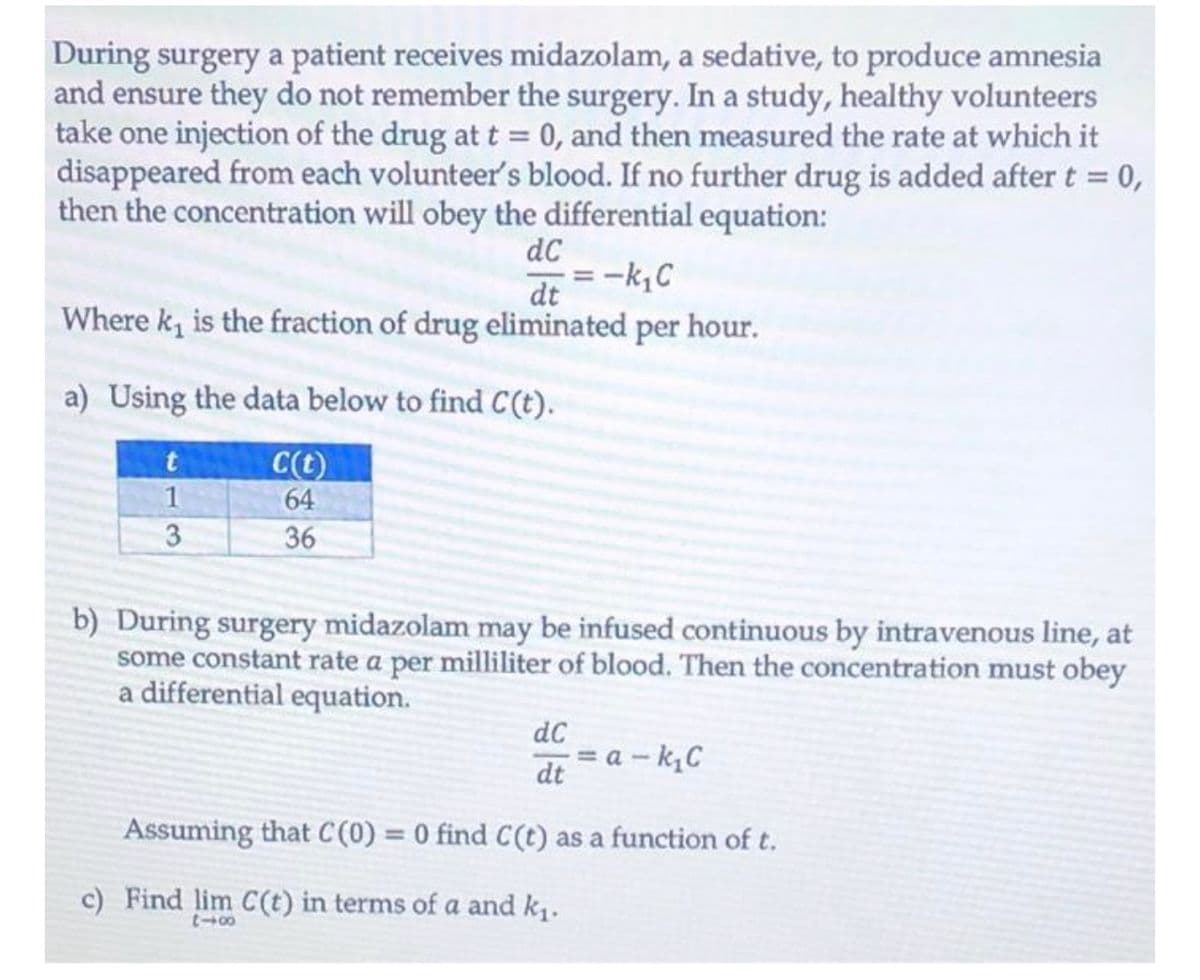During surgery a patient receives midazolam, a sedative, to produce amnesia and ensure they do not remember the surgery. In a study, healthy volunteers take one injection of the drug at t = 0, and then measured the rate at which it disappeared from each volunteer's blood. If no further drug is added after t = 0, then the concentration will obey the differential equation: dC = -k,C dt Where k, is the fraction of drug eliminated per hour. a) Using the data below to find C(t). C(t) 64 36 1 3 b) During surgery midazolam may be infused continuous by intravenous line, at some constant rate a per milliliter of blood. Then the concentration must obey a differential equation. dC a – k,C dt Assuming that C(0) = 0 find C(t) as a function of t. c) Find lim C(t) in terms of a and k1.
During surgery a patient receives midazolam, a sedative, to produce amnesia and ensure they do not remember the surgery. In a study, healthy volunteers take one injection of the drug at t = 0, and then measured the rate at which it disappeared from each volunteer's blood. If no further drug is added after t = 0, then the concentration will obey the differential equation: dC = -k,C dt Where k, is the fraction of drug eliminated per hour. a) Using the data below to find C(t). C(t) 64 36 1 3 b) During surgery midazolam may be infused continuous by intravenous line, at some constant rate a per milliliter of blood. Then the concentration must obey a differential equation. dC a – k,C dt Assuming that C(0) = 0 find C(t) as a function of t. c) Find lim C(t) in terms of a and k1.
Calculus: Early Transcendentals
8th Edition
ISBN:9781285741550
Author:James Stewart
Publisher:James Stewart
Chapter1: Functions And Models
Section: Chapter Questions
Problem 1RCC: (a) What is a function? What are its domain and range? (b) What is the graph of a function? (c) How...
Related questions
Question
100%
Please help I'm stuck

Transcribed Image Text:During surgery a patient receives midazolam, a sedative, to produce amnesia
and ensure they do not remember the surgery. In a study, healthy volunteers
take one injection of the drug at t = 0, and then measured the rate at which it
disappeared from each volunteer's blood. If no further drug is added after t = 0,
then the concentration will obey the differential equation:
dC
-k,C
dt
Where k, is the fraction of drug eliminated per hour.
a) Using the data below to find C(t).
C(t)
64
1
3
36
b) During surgery midazolam may be infused continuous by intravenous line, at
some constant rate a per milliliter of blood. Then the concentration must obey
a differential equation.
dC
= a - k,C
dt
Assuming that C(0) = 0 find C(t) as a function of t.
%3D
c) Find lim C(t) in terms of a and k1.
00-3
Expert Solution
This question has been solved!
Explore an expertly crafted, step-by-step solution for a thorough understanding of key concepts.
This is a popular solution!
Trending now
This is a popular solution!
Step by step
Solved in 2 steps with 3 images

Recommended textbooks for you

Calculus: Early Transcendentals
Calculus
ISBN:
9781285741550
Author:
James Stewart
Publisher:
Cengage Learning

Thomas' Calculus (14th Edition)
Calculus
ISBN:
9780134438986
Author:
Joel R. Hass, Christopher E. Heil, Maurice D. Weir
Publisher:
PEARSON

Calculus: Early Transcendentals (3rd Edition)
Calculus
ISBN:
9780134763644
Author:
William L. Briggs, Lyle Cochran, Bernard Gillett, Eric Schulz
Publisher:
PEARSON

Calculus: Early Transcendentals
Calculus
ISBN:
9781285741550
Author:
James Stewart
Publisher:
Cengage Learning

Thomas' Calculus (14th Edition)
Calculus
ISBN:
9780134438986
Author:
Joel R. Hass, Christopher E. Heil, Maurice D. Weir
Publisher:
PEARSON

Calculus: Early Transcendentals (3rd Edition)
Calculus
ISBN:
9780134763644
Author:
William L. Briggs, Lyle Cochran, Bernard Gillett, Eric Schulz
Publisher:
PEARSON

Calculus: Early Transcendentals
Calculus
ISBN:
9781319050740
Author:
Jon Rogawski, Colin Adams, Robert Franzosa
Publisher:
W. H. Freeman


Calculus: Early Transcendental Functions
Calculus
ISBN:
9781337552516
Author:
Ron Larson, Bruce H. Edwards
Publisher:
Cengage Learning